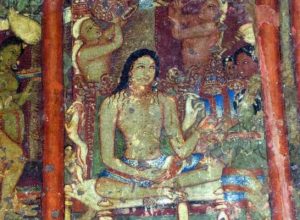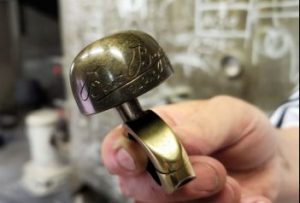Soft beauty in hard casts: bodhi presence in Shanxi
The province of Shanxi, located in the heart of China, enjoys a profound connection to Buddhism that has been forged over centuries. Among its most beautiful and spiritually significant contributions to Buddhist art and culture are the Iron Bodhisattvas. These statues, sometimes over a millennia old, are not only marvels of religious craftsmanship, but also bearers of deep symbolism within the Chinese Mahayana Buddhist tradition.
The history of the Iron Bodhisattvas
The Iron Bodhisattvas’ origins can be traced back to the Han Dynasty (202 BCE–9 CE; 25–220 CE), specifically period following Buddhism’s introduction into China. Revered for its spiritual power, the Iron Bodhisattva serves as an altar’s centerpiece, providing a focal point for devotion and prayer in Chinese Buddhism. There are also elements of syncretism that were characteristic of ancient Chinese folk spirituality. According to the principles of feng shui, placing the Iron Bodhisattva at the center is believed to enhance chi flow, thus bringing prosperity and good fortune to donors and the emperor. The creation of an Iron Bodhisattva requires commitment and finesse, as well as a solid knowledge of Buddhist philosophical principles. Crafted from molds, these statues are representations of prime celestials in the Mahayana pantheon. Historically, after the iron castings cooled, they were gilded with gold or bronze, creating resplendent figures that reflected the sacredness of their role. However, during tumultuous times, such as Emperor Wu’s (r. 561–78) reign, these icons were desecrated—stripped of their gold and reduced to remnants in a bid to suppress Buddhism while also confiscating temple wealth.
The embodiment of compassion and wisdom
But why bodhisattvas rather than the more traditional, central figure of reverence, the Buddha? Bodhisattvas are core to Mahayana Buddhism, elevated to positions beyond other traditions like the Theravada. They are beings who have generated bodhicitta, the mind of enlightenment (or the aspiration toward it), and have chosen to postpone their own entry into Nirvana in order to assist others in reaching enlightenment.
The oldest extant Iron Bodhisattva statues can hail from as early as the 5th century of the Common Era. They represent a confluence of ideas and aesthetics that are quintessentially Chinese. Buddhism, though of Indian origin, found its philosophy, metaphysics, and ethics a sympathetic ear in various medieval Chinese circles, where it intermingled with the prevailing Confucian and Daoist philosophies. The resulting Chinese Buddhist cultural system was profoundly etched into the nation and people’s religious beliefs, philosophical ideas, and artistic expressions. In the Shanxi region, the crafting of Iron Bodhisattvas became a physical manifestation of this spiritual ideal, embodying compassion and wisdom in a form that could be venerated by the faithful.
One cannot discuss Iron Bodhisattvas without mentioning two temples on Mount Wutai, which is located in the northeastern corner of Wutai County, Xinzhou City, Shanxi Province in the northeastern part of China. Wutaishan is a Buddhist sacred place for pilgrimage where the qīng miào (青廟) of Han Chinese Buddhism and the huáng miào (黃廟) of Tibetan Vajrayana Buddhism share the same mountain, where Mahayana monks and Vajrayana lamas can chant scriptures together. It is probably the most famous among China’s four great Buddhist mountains. On 26 June 2009, it was listed as a UNESCO World Heritage Site. This renowned mountain has been revered as the abode of Manjushri Bodhisattva since medieval times and attracts a continuous stream of pilgrims to this day, with some of the most important figures in contemporary Chinese Buddhism having temples or practice centers on the mountain. It holds a special place in the hearts of pilgrims and art historians alike.
Nestled between Mount Wutai’s north of the Southern Terrace and the south of the Central Terrace, the Golden Pavilion Temple (jingesi; 金閣寺), not to be mistaken with Kyoto’s more famous counterpart, stands at the highest point among the five main peaks of Mount Wutai, at an elevation of 1900 meters, where the climate is cold and the winds as sharp as knives.
The construction of the Golden Pavilion Temple, which was completed by 766 by Master Hanguang, was an endeavor of national significance, supported by the devotion of the entire country, from the imperial family—which supported Chinese esoteric Buddhism—to the commoners. The temple was completed after five years of extensive work, resulting in a majestic multi-tiered structure whose golden roof shone upon the valley, hence the name Golden Pavilion Temple.
The main attraction within the temple is the 17.7-meter tall statue of the Thousand-Handed Guanyin or Avalokiteshvara, a magnificent work of art that dominates the Great Compassion Hall. Crafted with an inner bronze statue and an outer layer of thin clay coated in gold, the image of Guanyin is both spiritually awe-inspiring and artistically breathtaking. This statue is not only unique on Mount Wutai but also a rare artistic marvel across China, second only to the great copper Buddha statues in Tashilhunpo Monastery in Tibet and Zhengding in Hebei.
The story of the Iron Bodhisattva reflects China’s timeless spiritual aesthetics and artistic expression. The Golden Pavilion Temple and its grand statue of Guanyin are not mere relics of the past but living embodiments of a cultural pilgrimage that continues to draw visitors from around the world, seeking solace and inspiration.
The Thousand-Bowl Manjushri Hall inside Xiantong Temple on Mount Wutai is another example of a classic Iron Bodhisattva. Xiantong Temple was constructed from 58 to 75 CE, during the Eastern Han DynastyThe hall has three sections to the west, is 13 meters wide, and 9 meters deep, with a hard mountain-style roof with coiled eaves. In the center of the hall, on the main altar, there is an unusual gilded bronze statue of Manjushri, standing 5.4 meters tall, which was cast in the ninth year of the Wanli era of the Ming Dynasty (1581).
This bronze statue of Manjushri Bodhisattva has a unique design, with five layers of heads stacked on top of each other, each layer featuring three faces that decrease in size from bottom to top. Although the faces are not exactly the same, they all shine with bright eyes and convey intelligence, radiating beauty not found in the common. Manjushri is depicted in a half-lotus position sitting on a lion, dressed in exquisite heavenly garb, with a seven-jewel buddha crown on his head.
Numerous arms stretch out from the sides of his body, and from each arm sprout countless hands, said to total one thousand. Each hand holds a golden bowl, and each bowl contains a statue of Shakyamuni Buddha. Therefore, the Thousand-Bowl Manjushri is also known as the “Thousand-Armed, Thousand-Bowl Shakyamuni Manjushri Bodhisattva Statue.” Whether it is the arms or hands, all of the celestial’s body parts are plump and tender, exuding youthful vitality. The two hands at the bottom, one shakes a bronze bell, and the other holds a vajra scepter. Both the bell and the scepter are ritual instruments, serving to remind people to awaken from their samsaric confusion and to behave according to the Dharma.
This Ming Dynasty sculpture, with its graceful form and exquisite craftsmanship, is a masterpiece of Chinese Buddhist art and is extremely precious for scholars, pilgrims, and devotees alike.
An iron-cast legacy
Shanxi’s Iron Bodhisattva statues are a testament to the enduring spiritual and artistic heritage of China. The Iron Avalokiteshvara at the Golden Pavilion Temple and the Iron Manjushri at Xiantong Temple embody the synthesis of compassion and wisdom that lies at the heart of Mahayana Buddhism. Standing amidst the serene peaks of Mount Wutai, these metallic monuments have withstood the test of time, echoing the ancient chants of monks and the fervent prayers of pilgrims. They are not merely relics but active symbols of mercy, beckoning modern visitors to partake in a timeless quest for enlightenment.
As we reflect on these majestic creations, we are reminded of the profound cultural heritage of Chinese Buddhism, which continues to inspire and fortify the human spirit. The Iron Bodhisattvas of Shanxi, in their silent majesty, invite us to look inward and strive onward, carrying the light of their legacy into the future.
See more
20150901~12品山西古蹟文物 賞內蒙自然風光~6 五台山菩薩頂.顯通寺.塔院寺和萬佛閣 (blog.udn.com)
Ancient Chinese Buddhist Sculpture (National Museum of China)
History of the Chinese Iron Buddha (LoveToKnow)
五台山,金閣寺,竟然供有一尊6層樓高的千手觀音像 (twgreatdaily.com)
五臺山文殊菩薩銅像 (hkcd.com)
Related features from BDG
The Fengxian Temple and Wu Zetian’s Esoteric Legacy
Pilgrimage: Mount Jiuhua, Kshitigarbha’s Geopark
Pilgrimage: Visiting the Buddhist Mountain of Wutaishan
















